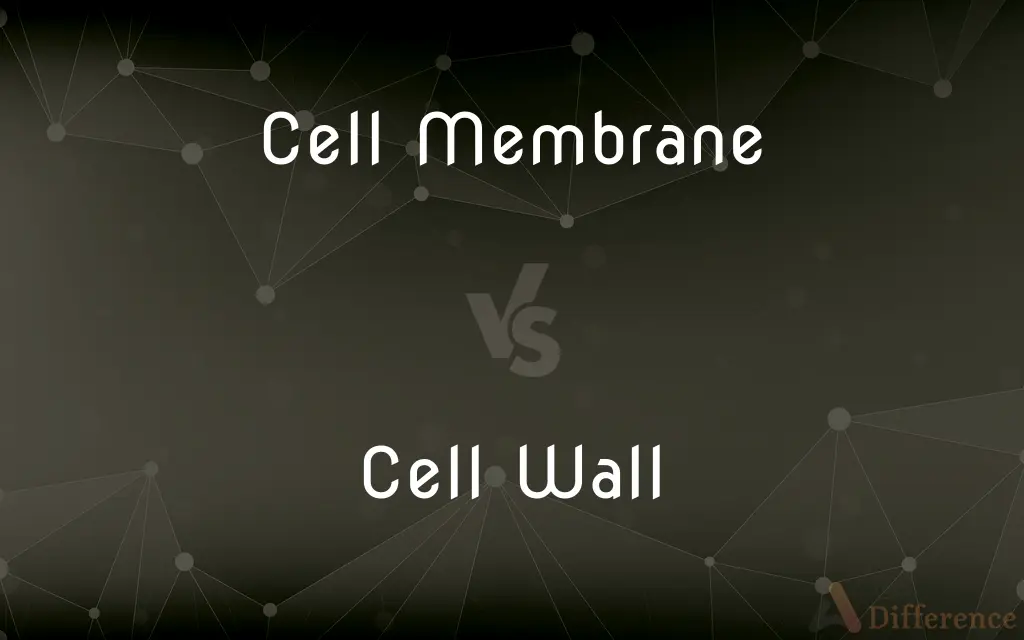Cell Membrane vs. Cell Wall — What's the Difference?
By Tayyaba Rehman — Published on October 22, 2023
Cell Membrane is a semi-permeable barrier enclosing cell contents; Cell Wall is a rigid structure providing support, mostly in plants.

Difference Between Cell Membrane and Cell Wall
Table of Contents
ADVERTISEMENT
Key Differences
The Cell Membrane, present in all cells, functions as a protective barrier that regulates the entry and exit of substances. On the contrary, the Cell Wall is an external, rigid structure that gives additional support and protection, primarily found in plants, fungi, and certain prokaryotes.
Cell Membranes are made up of a phospholipid bilayer interspersed with proteins. This structure ensures selective permeability, allowing certain molecules to pass through while keeping others out. The Cell Wall, however, consists of cellulose in plants, chitin in fungi, and peptidoglycan in bacteria, lending it rigidity and strength.
The flexibility of the Cell Membrane supports dynamic cellular processes, including endocytosis and exocytosis. The Cell Wall, being more static, primarily offers mechanical support, preventing plant cells from bursting due to osmotic pressure.
While the Cell Membrane is essential for maintaining cellular homeostasis, the Cell Wall plays a pivotal role in the overall structural integrity of plants, fungi, and certain bacteria. Both these components, though serving different primary functions, are integral for the survival and function of the cells they encase.
Compare with Definitions
Cell Membrane
Cell Membrane plays a role in cellular communication.
Receptors on the Cell Membrane receive signals from other cells.
ADVERTISEMENT
Cell Wall
Cell Wall composition varies among organisms.
While plants have a cellulose-based Cell Wall, fungi have one made of chitin.
Cell Membrane
Cell Membrane maintains cellular homeostasis.
By regulating substance movement, the Cell Membrane ensures a balanced internal environment.
Cell Wall
Cell Wall provides protection against external stress.
The Cell Wall protects plant cells from bursting under high osmotic pressure.
Cell Membrane
Cell Membrane is the semi-permeable layer surrounding cell contents.
The Cell Membrane controls the movement of substances into and out of the cell.
Cell Wall
Cell Wall is a rigid structure surrounding some cells.
The Cell Wall gives plants their structural rigidity.
Cell Membrane
Cell Membrane is involved in endocytosis and exocytosis.
The Cell Membrane can engulf particles or release substances using vesicles.
Cell Wall
Cell Wall aids in maintaining cell shape.
Thanks to the Cell Wall, plant cells retain a consistent shape even when turgid.
Cell Membrane
Cell Membrane consists of a phospholipid bilayer.
The Cell Membrane's unique structure ensures its selective permeability.
Cell Wall
Cell Wall is absent in animal cells.
Unlike plant cells, animal cells lack a Cell Wall, making them more flexible.
Cell Wall
Rare spelling of cell wall
Common Curiosities
Do all cells have a Cell Wall?
No, only plants, fungi, and certain prokaryotes have a Cell Wall.
What primarily composes the Cell Membrane?
The Cell Membrane is primarily composed of a phospholipid bilayer with embedded proteins.
Which cellular structure regulates substance movement?
The Cell Membrane regulates the movement of substances into and out of the cell.
Can substances freely pass through the Cell Membrane?
No, the Cell Membrane is selectively permeable, only allowing certain substances through.
What would happen to a plant cell without a Cell Wall in a hypotonic solution?
Without a Cell Wall, the plant cell could burst due to osmotic pressure.
What is the significance of the Cell Wall in fungi?
In fungi, the Cell Wall made of chitin provides protection and structural support.
How does the Cell Wall aid in preventing water influx in hypotonic solutions?
The Cell Wall provides rigidity, preventing the cell from over-expanding and potentially bursting due to water influx.
Why don't animal cells have a Cell Wall?
Animal cells rely on other structural and functional mechanisms and don't require the rigidity provided by a Cell Wall.
Why is the Cell Wall important for plants?
The Cell Wall provides structural support and protection, helping plants maintain shape and integrity.
How does the Cell Membrane aid in cell signaling?
The Cell Membrane has receptors that can receive and transmit signals from and to other cells.
What differentiates the composition of plant and bacterial Cell Walls?
Plant Cell Walls are made of cellulose, while bacterial Cell Walls are composed of peptidoglycan.
How does the Cell Membrane maintain cellular homeostasis?
By regulating the entry and exit of substances, the Cell Membrane ensures a stable internal cell environment.
Can the Cell Membrane facilitate active transport?
Yes, with the help of protein pumps, the Cell Membrane can move substances against their concentration gradient.
Is the Cell Membrane only present in eukaryotic cells?
No, the Cell Membrane is present in both eukaryotic and prokaryotic cells.
How does the rigidity of the Cell Wall benefit plants?
The Cell Wall's rigidity provides mechanical support, allowing plants to grow upright and resist external pressures.
Share Your Discovery

Previous Comparison
Marketing vs. Selling Concept
Next Comparison
Covalent Bonds vs. Ionic BondsAuthor Spotlight
Written by
Tayyaba RehmanTayyaba Rehman is a distinguished writer, currently serving as a primary contributor to askdifference.com. As a researcher in semantics and etymology, Tayyaba's passion for the complexity of languages and their distinctions has found a perfect home on the platform. Tayyaba delves into the intricacies of language, distinguishing between commonly confused words and phrases, thereby providing clarity for readers worldwide.
















































